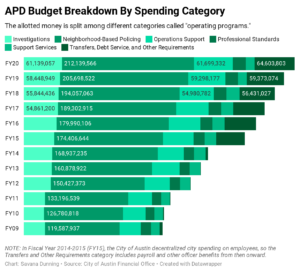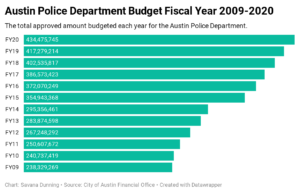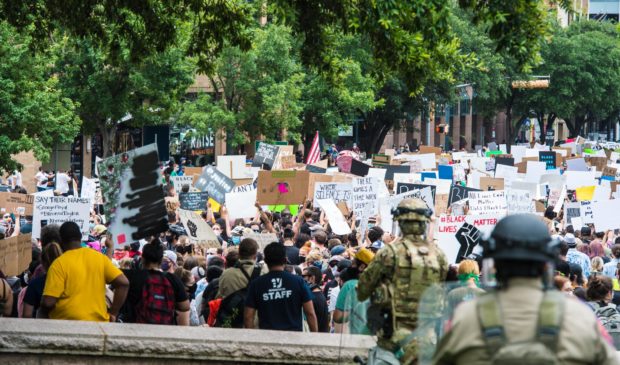What $100M from the APD budget looks like
Monday, June 29, 2020 by
Savana Dunning In response to pressure from activists to defund the Austin Police Department, City Council unanimously approved a series of reforms to APD operations, including a resolution that asks for deep cuts to the public safety budget.
The Austin Justice Coalition has asked Council to reallocate $100 million from APD’s budget in Fiscal Year 2021 to fund other departments that might provide alternatives to policing. However, Ed Van Eenoo, the city’s deputy chief financial officer, said while it might be possible to shave $10 million-$20 million from the budget, reaching $100 million in one year would be next to impossible.
“If you want to get to a $100 million reduction in the police department budget, you really are looking at how we just need to substantially scale back,” Van Eenoo said. “The number of officers that we have, we currently have 1,959 sworn personnel that provide patrol services, investigation services, command staff, internal affairs, airfare, helicopter – all those people are sworn personnel and that number would just have to be much, much smaller to get to $100 million.”

Austin spends around a quarter of its operating budget on General Fund departments, such as APD. In Fiscal Year 2020, the largest chunk of this General Fund budget – 39.9 percent – was dedicated to the police department, giving APD about $434.4 million to work with.
“Just to run a police department is a much more expensive endeavor than to, say, run an animal center,” Van Eenoo said. “It’s just the nature of the operations and the number of people that it requires to provide 24/7 around-the-clock patrol and investigations and communications and all that stuff.”
The Austin Police Department budget groups expenses by operating programs, with nearly half the amount of money, about 49 percent in FY 2019-20, being dedicated to neighborhood policing, which encompasses immediate dispatch, patrols, traffic enforcement and community partnership operations.
Bill Spelman, a criminal justice policy researcher and former Austin City Council member, said one issue with defunding police departments as a way to deter police violence is that policymakers have to make sure the department’s duties are adjusted to reflect the budget cut. He said a reduced amount of officers with the same amount of duties could inadvertently lead to increased police brutality.
“If you’re taking money out of the police department and giving it somebody else, and they’re also taking the work that they used to have to do, it’s not a big deal from the police department’s point of view,” Spelman said. “If, on the other hand, we are removing that money to try to punish them, and we’re going to give them the same amount of work, they have the same number of calls to answer, the same number of crimes to deal with, then … there might be all sorts of consequences which none of us really want to have happen going on downstream.”
AJC founder Chas Moore said the goal of the requested budget cut is to remove those police duties and give them to other departments.
“When you look at other city budgets like the neighborhood housing budget, alternatives to public safety like mental health crisis response and things of that nature, they’re in comparison extremely underfunded compared to the police budget,” Moore said. “When we look at conversations surrounding alternatives to policing and alternative routes to getting public safety results, we just think that $100 million is a great starting place to make sure we’re not over-policing ourselves.”

The proposed budget advocated by Austin Justice Coalition will set APD’s budget back to a little less than what the department had in 2015, a time when the total crime rate was dropped by 5 percent from 2014, but was higher than the 2018 crime rate.
But the crime rate is not necessarily what is used to determine budget increases from year to year.
In 2014, the city decided to decentralize employee pay and benefits, expenses that were applied altogether to the General Fund, and added them to department budget totals instead. For APD, this meant a budget increase of $59,586,907 from 2014 to 2015, inflating the appearance of the budget as the individual budget now reflects the costs of officers and staff pay and benefits.
“The police department budget is substantially driven by labor agreements that call out various pay provisions that are due to our public safety personnel,” Van Eenoo said.
Alongside regular percent increases in pay each, the city’s contract with the Austin Police Association also promised an addition of 30 officers per year for several years.
In 2018, the Austin Justice Coalition worked with the Austin Police Association and City Council to reach an agreement over the city and union’s work contract after the city struck down the original contract written up by the union for being too pricey. AJC helped work the price tag down to half of what it was.
Moore said City Council’s recent decision to pause the incoming cadet class and reallocate funds that are supposed to go to unfilled positions is a step in the right direction to achieving AJC’s goals.
“We won’t know until the budget for sure if it’s enough to get to that $100 million mark,” Moore said. “They seemed to deliberate what alternatives to public safety looked like in their purview and with the powers they have. I think it’s enough right now, because we haven’t gotten to budget conversation yet, but we won’t know until July 23rd if they’re taking appropriate steps.”
City Council will meet on July 23 for its first budget hearing and is scheduled to adopt the city budget in mid-August.
The Austin Monitor’s work is made possible by donations from the community. Though our reporting covers donors from time to time, we are careful to keep business and editorial efforts separate while maintaining transparency. A complete list of donors is available here, and our code of ethics is explained here.
You're a community leader
And we’re honored you look to us for serious, in-depth news. You know a strong community needs local and dedicated watchdog reporting. We’re here for you and that won’t change. Now will you take the powerful next step and support our nonprofit news organization?









